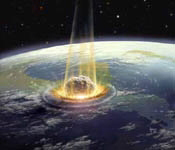
|
| ©n/a |
| We need to know more about natural space debris and their trajectories. |
The studies show that for now, the greatest risk comes from the smaller pieces of rock, which are no more than a few hundred metres across. Currently, a worldwide network of astronomers is cataloguing those objects above 1 kilometre in diameter. A number of survey telescopes are being used to detect as many as 90 percent of all near-Earth objects, down to a size of 140 metres, by around 2020. Only then will scientists know if space-based observatories will be required to hunt down the remainder.
The problem with such small pieces of rock is fixing their orbits, which from the ground is extremely difficult, and sometimes impossible to do. This means it is not possible to determine their trajectory with enough precision to rule out future impacts with our planet. For this reason, the ESA has been focusing on a mission that will 'mark a cross' on small asteroids.
The Don Quijote studies propose two phases. In phase one, a spacecraft would rendezvous with an asteroid and go in orbit around it, monitoring the asteroid for several months to determine its position, shape, mass and gravity field. In phase two, another spacecraft would crash into the asteroid at a speed of around 10km/s, while the first spacecraft will observe any changes in the asteroid's trajectory. This would be the first time a mission involving two spacecraft would attempt to move an asteroid and be capable measuring the result.
The Don Quijote studies intend to start off small. In its current form, the first spacecraft, Sancho, is capable of reaching any one of five or six small, nearby asteroids. Each one is no larger than a few hundred metres in diameter. The mission will focus on Apophis, a small asteroid that can swing dangerously close to earth on the outward stretch of its orbit around the sun.
If Don Quijote becomes a reality, the spaceship could be launched sometime early in the next decade, with Sancho taking about 25 months to reach its target. 'The idea is to get the technology ready before you really need it,' says Ian Carnelli, Technical Officer for the Don Quijote studies at ESA's General Studies Programme.
Comment: By the time this technology is ready, it might well be too late. More and more incidents about space debris hitting the earth are being reported these days. Just a couple of recent examples:
Meteor lights up the sky
Meteor Flash Lights Up Sky - California
As for those who think there is no threat from space, don't forget the Tunguska event in 1908, when a 20-metre meteorite impacted a Siberian forest and devastated an area of 2000 square kilometres. Scientists predict such an event occurs about every 150 years. Next year is the 100th anniversary of the incident, and it will be a timely reminder of the need to study and deal with the space debris threatening our planet.



Reader Comments
to our Newsletter